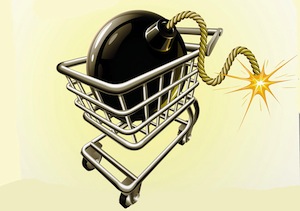 Mike Anthony and I recently published a book called The Shopper Marketing Revolution. Since its publication we’ve been asked a number of times ‘what is revolutionary about shopper marketing?’. Every time I’m asked this question, my answer is that shopper marketing is not the revolution; the revolution is the change in the total approach to the way brands are being marketed – shopper marketing is just the catalyst.
Mike Anthony and I recently published a book called The Shopper Marketing Revolution. Since its publication we’ve been asked a number of times ‘what is revolutionary about shopper marketing?’. Every time I’m asked this question, my answer is that shopper marketing is not the revolution; the revolution is the change in the total approach to the way brands are being marketed – shopper marketing is just the catalyst.
In our view the marketing model that most consumer goods companies use today has worked for us since it matured back in the fifties. It’s driven by the pretty simple idea that a company can be successful by building a huge brand and ensuring that brand is effectively distributed to the market.
A creaking model
This model was creaking even when I left university back in the very early 90’s. It’s true to say that media fragmentation was a reality then, as were consolidated retailers, and the combination of the two meant even 25 years ago that the way we do business needed to change. A lot of the way we thought back then was led by a very singular view of the customer – I think pretty much every marketer believed at that time that the only customer that was important was the consumer – the person that ended up using the product.
Today we know that’s not true; in order to get a brand into a consumer’s body, house, car or wherever, we know somebody has to buy it. So since P&G started talking about FMOT (the First Moment of Truth), it’s been accepted that the shopper is another important customer. If you accept that to be true then the retailer – the person who makes the brand available to shoppers – must also be important and should be considered as a third customer.
New rules needed
So modern marketers now grasp that in order to be successful, they need to understand and influence the behaviors of the consumers, shoppers and retailers. The rules of the old marketing model simply weren’t written to address this modern truth, and so we assert that old rule book needs to be thrown out and replaced by one that fits with the rapidly changing and complex world we face today.
The real revolution here is creating a rule book that recognizes in a storm of change, that marketers must always satisfy the needs of consumers, shoppers and retailers – hence the ‘shopper marketing revolution’. This requires a lot of changes in the way businesses operate today, and much of the book focuses on the changes that are needed to make that rule book work.
Total Marketing
At the heart of our thinking is a five step model which makes adopting the new rules of marketing simpler and more effective. We call this process Total Marketing:

Mike and I built everything we have learnt from over four decades of combined experience in consumer goods into this simple unifying model. We begin with the principle that everything is driven by consumption. Understanding a consumption opportunity helps us identify the desired shopping behavior: for consumption to grow someone needs to buy differently. By understanding shopper behavior, we can work out which channels, which stores, are important to fuel that growth, and we prioritize these. At this point we design a marketing mix designed to deliver both consumption and desired shopping behavior. With all that worked out – the right investment can be tuned: to focus on the right activities which will drive the right growth.
Winning with Total Marketing
Mike and I have seen exceptional results in companies that adopt this approach. In many cases this arises from aligning the business around a common purpose: driving consumption. Ultimately if you can’t get more people consuming products, more often and in greater quantities, you won’t grow.
We’ve found that by creating a clear distinction between driving consumption behavior and driving purchase behavior, marketing activities become much more focused on their required outcome. What is also cool about this, is that this distinction between consumption behavior and shopping behavior creates a common language between manufacturers and retailers, and this a point of union that is lacking in most relationships today.
But perhaps most importantly, we’ve found that investments will flow to the points where they will be most effective. This approach has proven to deliver massive improvements in real ROI on marketing investments, converting cost into profit. We know this because we measure this with our clients and we know that their investments pay back rapidly and significantly.
If you want to revolutionize the way you market your brands, why not start today? Get your copy of The Shopper Marketing Revolution.